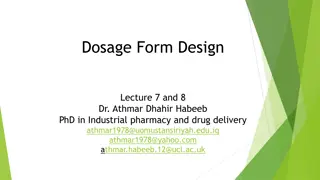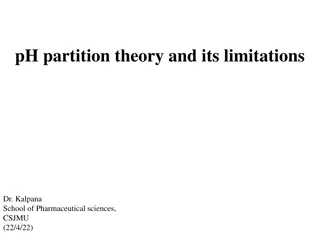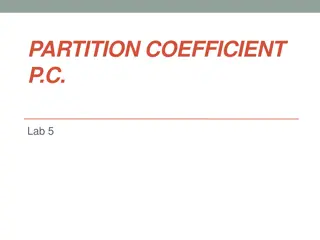Age-Friendly App: Managing Drug-Drug Interactions Between Prescriptions and OTC Analgesics
The Age-Friendly app addresses the crucial issue of drug-drug interactions between current prescriptions and over-the-counter analgesics in the geriatric population. With a significant percentage of OTC sales attributed to older adults, there is an increased risk of adverse drug events due to polyph
1 views • 25 slides
Pharmacokinetics Lecture: Clinical Applications and Dosage Regimens
Explore the pharmacokinetics lecture focusing on clinical implications such as changes in drug half-life in various patient conditions. Learn about dosage regimen design and optimization, including considerations for achieving therapeutic drug levels. Discover clinical situations requiring dosage ad
4 views • 53 slides
Understanding Posology in Pharmacology: Factors Affecting Drug Dosage
Posology, the science of determining drug dosage, is influenced by various factors including age, sex, body weight, route of administration, and more. Changes in pharmacokinetics with age, differing drug responses in men and women, and the importance of body weight in dosing are crucial consideratio
6 views • 23 slides
Overview of Pharmaceutical Powder Dosage Forms
Pharmaceutical powder dosage forms are the foundation of many solid dosage forms like tablets and capsules. They offer advantages such as ease of preparation, longer shelf life, and versatility in mixing medications. However, they also come with challenges such as unpleasant taste and difficulty in
7 views • 16 slides
Exploring the Benefits and Dosage of Hemp Seeds
Hemp seeds, often referred to as hemp hearts, are the edible seeds of the hemp plant (Cannabis sativa). They have gained popularity in recent years due to their numerous health benefits and versatility in culinary applications. In this article, we will delve into the various health benefits of hemp
13 views • 4 slides
Letermovir Tablets 35 mg: Optimizing Dosage for Best Results
At Impomed Healthcare, we emphasize the importance of optimizing the dosage of Letermovir Tablets 35 mg to achieve the best clinical outcomes. Proper dosage ensures effective prevention of cytomegalovirus (CMV) infections in patients undergoing stem cell transplants. Our guide provides essential inf
0 views • 10 slides
Anagrelide 0.5mg: An Effective Treatment for Essential Thrombocythemia
Efficacy and Dosage Efficacy & Dosage Efficacy of Anagrelide (0.5mg) What is Anagrelide? Essential thrombocythaemia is a condition in which an excessive amount of platelets are present in the blood. Anagrelide 0.5 mg inhibits the production of platelets, thereby reducing the risk of blood clotting,
0 views • 3 slides
Understanding Exponential Decay in Ibuprofen Dosage
Explore the concept of exponential decay using an example of ibuprofen dosage elimination from the bloodstream. Learn how to calculate the remaining dosage at different time intervals based on the decay rate. Discover the relation between the initial dosage, elimination rate, and time passed.
2 views • 22 slides
Understanding Regulatory Requirements of Drugs and Pharmaceuticals
Drug regulation involves controlling drug use through international agreement authorities like the FDA, EMA, and PMDA. The FDA plays a crucial role in drug evaluation and research, biologic evaluation, devices, and food safety. There are various types of applications for drug approval, along with a
0 views • 28 slides
Understanding Dosage Forms and Excipients in Medication Design
Dosage forms play a crucial role in the safe delivery and effectiveness of medications. They serve various purposes such as protecting drugs from environmental factors, controlling drug release, and providing different routes of administration. Excipients like flavors, colorants, and preservatives a
0 views • 27 slides
Polymeric Controlled Drug Delivery Systems
Polymeric controlled drug delivery systems play a crucial role in regulating drug release through diffusion, solvent penetration, and chemical mechanisms. These systems include diffusion-controlled, solvent-controlled, and chemically-controlled devices, each operating based on specific principles. S
0 views • 33 slides
Renal Pharmacology: Drug Excretion and Renal Clearance Questions
This comprehensive set of questions and answers covers topics related to drug excretion and renal pharmacology. It includes information on glomerular filtration, drug excretion mechanisms, dosage adjustments in renal impairment, factors influencing drug excretion, and the effects of long-term NSAID
0 views • 55 slides
Understanding Nasopulmonary Drug Delivery System
Nasopulmonary drug delivery system, utilizing the nasal route for drug administration, offers advantages such as hepatic first-pass metabolism avoidance and rapid drug absorption. This system is beneficial for pharmacologically active compounds with poor stability in gastrointestinal fluids. While i
0 views • 35 slides
Understanding Physicochemical Properties of Drugs
The physicochemical properties of drugs play a crucial role in their pharmacological effects. These properties include physical and chemical characteristics that influence interactions with biomolecules. Solubility, partition coefficient, and dissociation constant are key factors affecting drug beha
1 views • 46 slides
Understanding Formulary Systems in Healthcare
A formulary is a dynamic list of medications curated by healthcare professionals to guide drug selection based on efficacy, safety, cost, and patient acceptability. It plays a vital role in promoting evidence-based and cost-effective drug therapy, improving communication between prescribers and phar
0 views • 17 slides
Ways to Stay Drug Free: Lessons for Teens and Families
Understanding the reasons behind drug usage among teens, this lesson provides valuable resources and strategies to stay drug-free. It emphasizes the importance of making healthy decisions and offers alternatives to drug use. Additionally, it highlights the significance of saying no to drugs, provide
0 views • 17 slides
Understanding the Hatch-Waxman Act: Promoting Affordable Generic Drugs
The Hatch-Waxman Act, also known as The Drug Price Competition and Patent Term Restoration Act, was enacted in 1984 to amend patent laws and the Federal Food, Drug, and Cosmetic Act. It aims to reduce costs associated with generic drug approval, allow early experimental use, compensate branded drug
0 views • 49 slides
Essential Concepts in Dosage Form Design
Understanding the formulation and design of dosage forms is crucial in pharmaceutical sciences. Drug substances are combined with nonmedicinal agents to create stable, effective, and safe products. Considerations such as compatibility, quality control, labeling, and storage play key roles in dosage
4 views • 35 slides
Understanding Biopharmaceutics: pH Partition Theory and Drug Absorption
Biopharmaceutics explores how drug properties and administration methods impact drug absorption. Factors affecting oral absorption include membrane physiology and drug partitioning based on pH levels. The pH partition theory, explained by Brodie et al., highlights the role of drug lipid solubility a
0 views • 9 slides
Importance of In-Vitro Dissolution Testing in Drug Assessment
In drug development, in-vitro dissolution testing plays a crucial role in evaluating drug release from tablets when in-vivo bioavailability studies are limited. By ensuring drug release is close to 100% and uniform batch to batch, these tests help assess drug availability and effectiveness. Regulato
11 views • 10 slides
Understanding Biopharmaceutics and Pharmacokinetics in Drug Development
Biopharmaceutics and pharmacokinetics play essential roles in the research, development, and optimization of pharmaceutical products. Biopharmaceutics focuses on the interrelationship of drug properties, dosage forms, and administration routes on drug absorption, while pharmacokinetics delves into d
0 views • 16 slides
Understanding Medication Therapy: Problems and Solutions
Many patients, especially the elderly, face challenges with multiple medication therapy due to impaired eyesight and complex drug regimens. Proper identification of medications is key, with distinct sizes, shapes, and colors aiding in differentiation. Performing formulation studies before developing
0 views • 20 slides
Understanding Partition Coefficient in Pharmaceuticals
Partition coefficient (P.C.) is crucial in pharmaceuticals for various reasons such as preserving oil/water systems, drug distribution in the body, extraction processes, and dosage form formulations. It involves the distribution of a solute between two immiscible liquids based on equilibrium express
0 views • 10 slides
Understanding Quantitative Aspects of Drug Action
Explore the quantitative aspects of drug action, including drug receptor binding, concentration binding curves, dose-response curves, and types of antagonism. Learn to relate drug concentration to receptor binding capacity and response produced. Discover how concentration binding curves and dose-res
0 views • 29 slides
Pharmaceutical Dosage Form Design and Drug Delivery Systems Overview
Understanding pH-solubility profiles of drugs like indomethacin, chlorpromazine, and oxytetracycline is crucial in formulating pharmaceuticals. Factors affecting dissolution rates, such as particle size and solubility, can be optimized to enhance drug absorption. Different methods like particle size
0 views • 46 slides
Understanding IVIVC in Pharmaceutical Sciences
In the field of pharmaceutical sciences, In Vitro-In Vivo Correlation (IVIVC) plays a crucial role in predicting the relationship between in vitro dissolution rates of drug dosage forms and in vivo absorption rates. This correlation is essential for bioequivalence studies, reducing the number of tri
0 views • 24 slides
Understanding Drug Administration Routes and Dosage Forms
This chapter explores the various routes of drug administration and dosage formulations, including oral, topical, and parenteral forms. It covers topics like inactive ingredients in tablets, suspension versus emulsion liquid forms, advantages and disadvantages of different formulations, stability of
2 views • 65 slides
Veterinary Prescription Cost Calculations
Learn how to calculate the cost of veterinary prescriptions based on total dosage, drug strength, and unit cost. Two scenarios are provided with detailed calculations for determining the total cost of the prescription. Understand how to convert units, calculate total dosage required, determine the n
0 views • 11 slides
Principles of Pharmacy Practice - Drug Dosing Guidelines and Measurements
Understanding drug dosing is crucial in pharmacy practice. This lecture covers various aspects of doses, including adult and pediatric doses, dosage regimens, median effective and toxic doses, loading and maintenance doses, and prophylactic and therapeutic doses. Dose measurements in institutional s
0 views • 16 slides
Ceftazidime Dosage Modification in Renal Failure Cases
Ceftazidime dosage adjustments are crucial in patients with renal impairment to prevent toxicity or suboptimal treatment. Factors like renal function, drug elimination route, and therapeutic window must be considered. Proper dosing ensures effective treatment while avoiding adverse effects in patien
0 views • 33 slides
Impact of Socioeconomic Conditions on Drug Use Disorders: Insights from World Drug Report 2020
The World Drug Report 2020 highlights the strong correlation between socioeconomic factors and drug use disorders. Studies reveal that communities facing poverty, violence, and social inequality are at a higher risk of drug overdoses and addiction. Factors like income inequality, lack of social capi
1 views • 17 slides
In Vitro Dissolution Study of Per Oral Tablet: Understanding Drug Absorption
Dissolution is a crucial process for drug absorption, where solid dosage forms must dissolve in gastrointestinal fluid before absorption. Factors affecting dissolution rate include agitation intensity, drug solubility, and surface area exposed to the dissolution medium. Dissolution testing plays a k
0 views • 12 slides
Understanding Targeted Clinical Investigation in Pharmacovigilance
Targeted clinical investigation plays a crucial role in pharmacovigilance by further evaluating significant risks identified in pre-approval clinical trials. This involves conducting pharmacokinetic and pharmacodynamic studies, genetic testing, interaction studies, and large simplified trials to ass
0 views • 12 slides
Pharmaceutical Ingredients and Excipients in Dosage Form Design
Producing drug substances in their final dosage forms involves various pharmaceutical ingredients like solvents, flavors, colorants, preservatives, and stabilizers. Different dosage forms such as tablets, ointments, creams, and suppositories require specific excipients for formulation. The appearanc
0 views • 29 slides
Quality Issues in Clinical Trial Materials: CMC Review by Dr. Dorota Matecka
Clinical trial materials undergo Chemistry, Manufacturing, and Controls (CMC) review to ensure pharmaceutical quality. This process includes assessing safety concerns, impurities, and specifications, along with other CMC considerations. Pharmaceutical quality encompasses the suitability, identity, s
0 views • 41 slides
Advances in Ophthalmic Drug Delivery Systems
This content explores various advanced ophthalmic drug delivery systems including erodible ophthalmic inserts, soluble ocular drug inserts, new ophthalmic drug delivery systems, and bioadhesive ophthalmic drug inserts. These innovative systems aim to provide accurate dosing, prolonged drug release,
0 views • 8 slides
Innovative Online Learning for Drug Court Professionals
Center for Court Innovation has introduced a new National Drug Court Online Learning System aimed at assisting drug court professionals. This system offers free access to web-based training, expert video lessons, virtual site visits to drug treatment courts, practitioner interviews, and a resource l
0 views • 8 slides
Understanding Drug Testing Policies in the Workplace
The Drug-Free Workplace Act of 1988 mandates federal grant recipients to implement zero-tolerance drug policies to maintain a drug-free environment. Employers must establish clear policies, conduct awareness programs, offer counseling and rehabilitation services, and impose penalties for violations.
0 views • 19 slides
Understanding Medication Administration and Drug Calculations
Exploring the fundamentals of medication administration, including types of medication, common drug groups, the importance of the "Six Rights," common drug abbreviations, routes of administration, and drug calculation formulas. Examples provided for dosage calculations using Metoprolol and Phenytoin
0 views • 22 slides
Overview of International Drug Control Efforts and Challenges in 2015-2016
The content highlights significant events related to international drug control efforts, emphasizing the launch of the INCB Annual Reports, the UNGASS session at the United Nations, and the focus on health, welfare, and challenges in combating drug abuse. It discusses issues such as new psychoactive
0 views • 13 slides







































